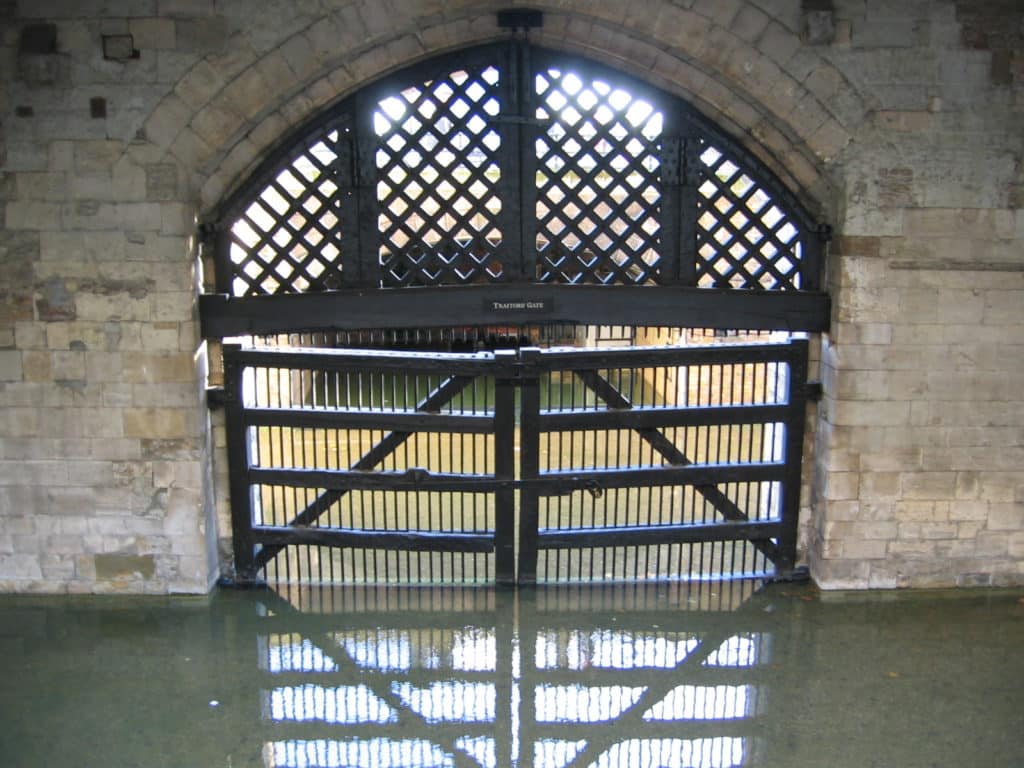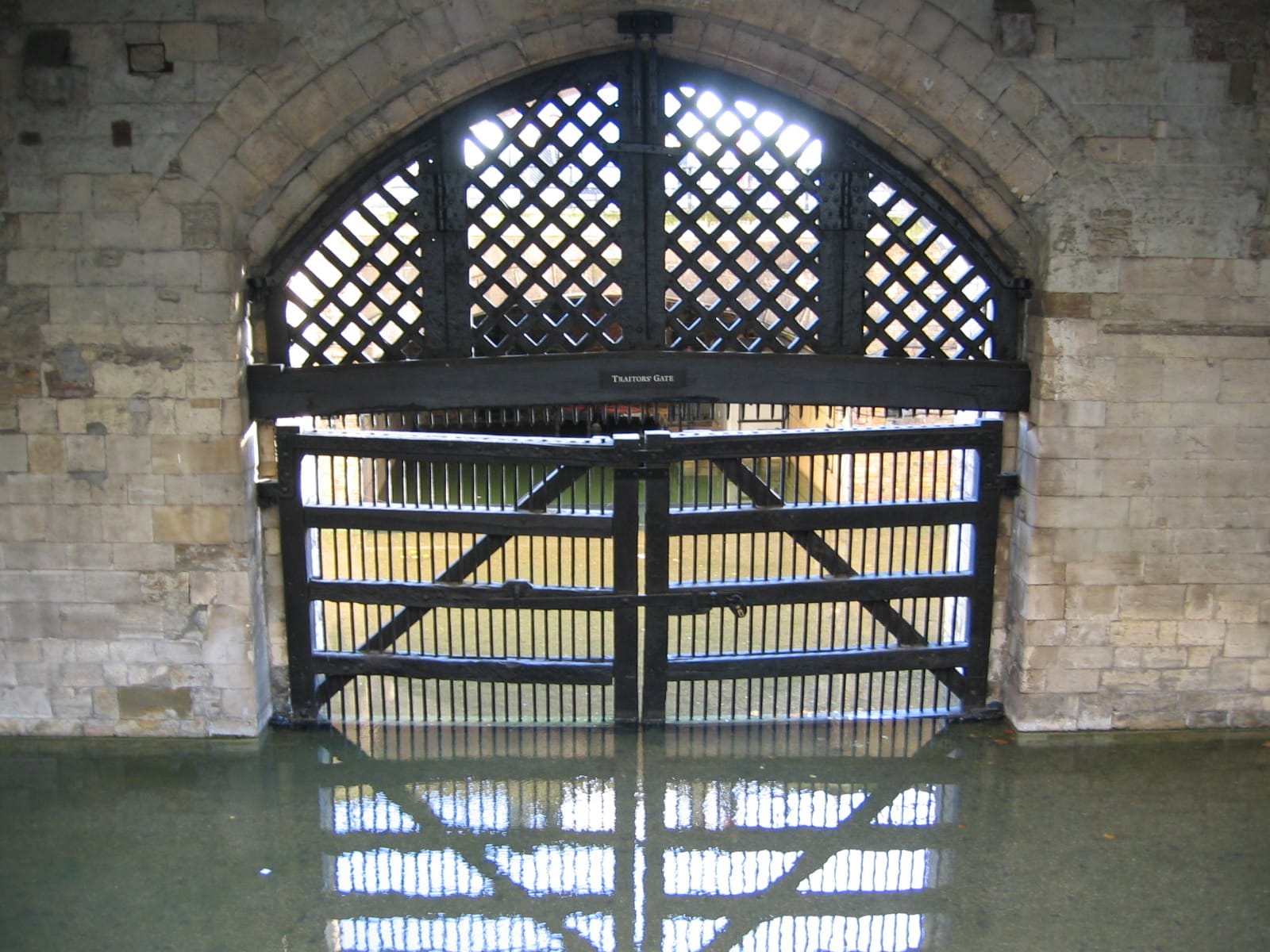
That morning while she was watching tennis, Anne was summoned to appear before the Privy Council. There, the Duke of Norfolk (her uncle), Sir William Fitzwilliam and Sir William Paulet told her that she was suspected of having committed adultery. They also mentioned that two of her alleged paramours were already under arrest – and one (Mark Smeaton) had confessed. The men ignored her protestations of innocence, and ordered her arrest. She was kept in her apartments until 2:00, when the tide changed and they could take her to the Tower.
By that time, a crowd had assembled on the banks or in boats to watch her barge pass and enter the Tower by Traitors’ Gate. Sir William Kingston, Constable of the Tower, wrote a moving description of her arrival and the dread that clearly gripped her:
On my lord of Norfolk and the King’s Council departing from the Tower, I went before the Queen into her lodging. She said unto me, “Mr. Kingston, shall I go into a dungeon?” I said, “No, Madam. You shall go into the lodging you lay in at your coronation.” “It is too good for me, she said; Jesu have mercy on me;” and kneeled down, weeping a [good] pace, and in the same sorrow fell into a great laughing, as she has done many times since. “She desired me to move the King’s Highness that she might have the sacrament in the closet by her chamber, that she might pray for mercy, “for I am as clear from the company of man as for sin as I am clear from you, and am the King’s true wedded wife.” And then she said, Mr. Kingston, “Do you know wherefor I am here?” and I said, “Nay.” And then she asked me, “When saw you the King?” and I said “I saw him not since I saw him in the tiltyard.” And then, “Mr. Kingston, I pray you to tell me where my Lord, my father is.” And I told her I saw him afore dinner in the Court. “O where is my sweet brother?” I said “I left him at York Place;” and so I did. “I hear say,” said she, “that I should be accused with three men; and I can say no more but nay, without I should open my body.” And therewith opened her gown. “O, Norris, hast thou accused me? Thou art in the Tower with me, and thou and I shall die together; and, Mark, thou art here too. O, my mother, thou wilt die with sorrow;” and much lamented my lady of Worcester, for by cause that her child did not store in her body. And my wife said, “What should be the cause?” And she said, “For the sorrow she took for me.”
And then she said, “Mr. Kingston, shall I die without justice?” And I said, “The poorest subject the King hath, hath justice.” And therewith she laughed.
I have to say, the laugh is the part that always gets me. She had a better understanding than most what her husband was capable of.
SOURCES:
Letters and Papers, Henry VIII: May 1536, 1-10
Luminarium: Encyclopedia Project
***
If you like my posts, you’ll love my books! My Seymour Saga trilogy tells the gripping story of the short-lived dynasty that shaped the Tudor Era. Jane the Quene skews romantic, The Path to Somerset is pure Game of Thrones (without the dragons), and The Boy King is a noir coming-of-age. Get them now through Amazon, Barnes & Noble, Kobo, and Apple, or even your local independent bookstore!

(PS Already read them? Did you love them? Then please review them – even just a stars rating! It makes a huge difference in helping new readers find them and would mean the world to me!)

Thank you for posting this, Janet. I have never read this passage before. It is chilling, somehow. And you’re right – the laugh says it all.
What does the laughter say? To me is says fear.
Fear absolutely, but so much more than that. Also recognition, irony….
poor anne she must have thought she was having a nightmare and henry would come and put an end to it and her life would continue she was devoted to henry unfortunately he had jane seymore in his sights and wanted anne out the way quickly did not want it to drag on like his first marriage I believe her laughter had two meanings one of nerves and one that she could not believe this was happening
Some reports say that she kept looking around at her execution, as if she could not believe that a countermanding order wasn’t arriving….heart wrenching.
The so called “Traitor’s Gate” was then known as the “Water Gate”, (not to be confused with the later one of Nixon).
Contrary to beliefs, Princess Elizabeth did not later enter the Tower by the “Water Gate”, but by the “Tower Gate”.